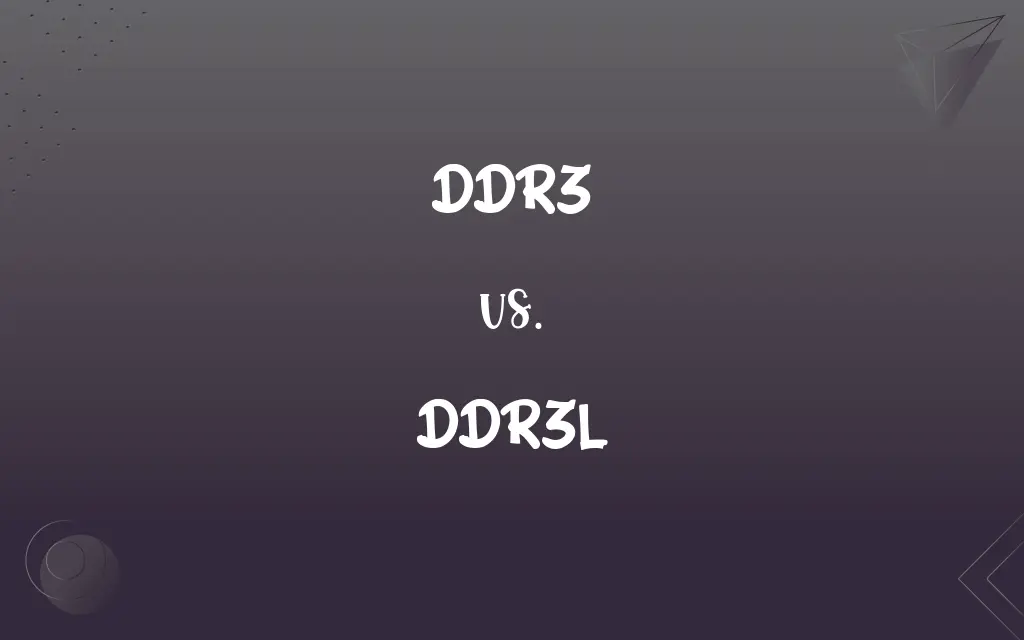DDR3 vs. DDR3L: What's the Difference?
Edited by Aimie Carlson || By Harlon Moss || Published on February 25, 2024
DDR3 is a type of RAM known for high-speed data transfer, while DDR3L is a low-voltage variant of DDR3, offering energy efficiency with similar performance.

Key Differences
DDR3 (Double Data Rate 3) is a type of RAM used in computers, known for its high-speed data transfer and improved performance over its predecessor DDR2. DDR3L is essentially the "L" variant of DDR3, where the "L" stands for low voltage, designed to operate at a lower voltage than standard DDR3.
The standard voltage for DDR3 RAM is 1.5V, which was a reduction from the previous DDR2 memory. In comparison, DDR3L operates at a lower voltage of 1.35V, making it more power-efficient, an important feature for battery-powered devices like laptops.
DDR3 memory modules are commonly used in desktops, laptops, and servers, offering significant improvements in bandwidth and performance. DDR3L modules are specifically beneficial in environments where power consumption is a critical factor, such as in ultrabooks and mobile devices.
Compatibility wise, DDR3L is designed to be backwards compatible with DDR3 slots, meaning it can function in a 1.5V DDR3 slot. However, standard DDR3 RAM is not designed to operate at the lower voltage of DDR3L, and using it in a 1.35V slot can lead to compatibility issues.
In terms of performance, both DDR3 and DDR3L offer similar data transfer rates and timings. The primary difference lies in the voltage operation and power consumption, with DDR3L being the more energy-efficient option.
ADVERTISEMENT
Comparison Chart
Voltage
Operates at 1.5V
Operates at 1.35V, lower power usage
Compatibility
Standard for most systems
Backwards compatible with DDR3 systems
Power Consumption
Higher compared to DDR3L
More energy-efficient
Performance
High-speed data transfer
Similar performance at lower voltage
Use Case
Widely used in desktops and servers
Ideal for laptops and energy-conscious devices
ADVERTISEMENT
DDR3 and DDR3L Definitions
DDR3
A type of RAM offering high-speed data transfer and improved bandwidth.
My computer's performance improved significantly after upgrading to DDR3 memory.
DDR3L
A low-voltage version of DDR3 RAM, operating at 1.35 volts.
Upgrading to DDR3L RAM is great for extending my laptop's battery life.
DDR3
A common memory type in various electronic devices.
From gaming consoles to servers, DDR3 is widely used.
DDR3L
Energy-efficient DDR3 memory variant.
DDR3L is ideal for devices where power consumption is a concern.
DDR3
A memory standard that operates at 1.5 volts.
DDR3 modules are compatible with motherboards designed for 1.5V RAM.
DDR3L
Offers similar performance to DDR3 but with reduced power usage.
DDR3L doesn't compromise on speed despite its lower voltage.
DDR3
Known for its high bandwidth interface.
DDR3 RAM can handle demanding applications due to its high bandwidth.
DDR3L
Compatible with both 1.35V and 1.5V memory slots.
I chose DDR3L for its versatility and compatibility with different motherboards.
DDR3
Third-generation Double Data Rate memory technology.
Most computers from that era use DDR3 RAM.
DDR3L
Suitable for ultrabooks and mobile devices.
Many modern ultrabooks come equipped with DDR3L RAM for efficiency.
FAQs
What voltage does DDR3 operate at?
DDR3 typically operates at 1.5 volts.
What is DDR3 RAM?
DDR3 is a type of RAM known for high-speed data transfer and improved bandwidth.
Is there a performance difference between DDR3 and DDR3L?
They offer similar performance, but DDR3L is more power-efficient.
Is DDR3 better than its predecessor?
Yes, DDR3 offers improved performance over DDR2.
What is DDR3L RAM?
DDR3L is a low-voltage version of DDR3, operating at 1.35 volts.
What is the advantage of DDR3L over DDR3?
DDR3L is more energy-efficient, making it ideal for laptops.
Can DDR3L be used in a DDR3 slot?
Yes, DDR3L is backwards compatible with DDR3 slots.
Is DDR3 still widely used?
Yes, DDR3 is still commonly used in many systems.
What devices commonly use DDR3?
DDR3 is used in desktops, laptops, and servers.
Can DDR3 be used in any motherboard?
It must be used in motherboards that support 1.5V DDR3 slots.
Can I replace DDR3 with DDR3L?
Yes, if your motherboard supports the lower voltage of DDR3L.
Is DDR3L more expensive than DDR3?
The price can vary, but DDR3L may be slightly more expensive due to its efficiency.
Are there any downsides to using DDR3L?
One downside could be compatibility issues with older hardware not designed for low-voltage RAM.
How do I know if my system requires DDR3 or DDR3L?
Check your system's specifications or motherboard manual to determine the required RAM type.
What type of devices is DDR3L best suited for?
DDR3L is ideal for laptops and energy-conscious devices.
Does DDR3 consume more power than DDR3L?
Yes, DDR3 typically consumes more power as it operates at a higher voltage.
Can DDR3L improve battery life in laptops?
Yes, due to its lower power consumption, DDR3L can help extend laptop battery life.
What does 'L' in DDR3L stand for?
The 'L' in DDR3L stands for low voltage.
Is the installation process the same for DDR3 and DDR3L?
Yes, the installation process is similar, but it's important to ensure compatibility with the motherboard.
About Author
Written by
Harlon MossHarlon is a seasoned quality moderator and accomplished content writer for Difference Wiki. An alumnus of the prestigious University of California, he earned his degree in Computer Science. Leveraging his academic background, Harlon brings a meticulous and informed perspective to his work, ensuring content accuracy and excellence.
Edited by
Aimie CarlsonAimie Carlson, holding a master's degree in English literature, is a fervent English language enthusiast. She lends her writing talents to Difference Wiki, a prominent website that specializes in comparisons, offering readers insightful analyses that both captivate and inform.































































